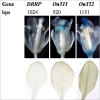Integration of molecular biology tools for identifying promoters and genes abundantly expressed in flowers of Oncidium Gower Ramsey
- PMID: 21473751
- PMCID: PMC3079641
- DOI: 10.1186/1471-2229-11-60
Integration of molecular biology tools for identifying promoters and genes abundantly expressed in flowers of Oncidium Gower Ramsey
Abstract
Background: Orchids comprise one of the largest families of flowering plants and generate commercially important flowers. However, model plants, such as Arabidopsis thaliana do not contain all plant genes, and agronomic and horticulturally important genera and species must be individually studied.
Results: Several molecular biology tools were used to isolate flower-specific gene promoters from Oncidium 'Gower Ramsey' (Onc. GR). A cDNA library of reproductive tissues was used to construct a microarray in order to compare gene expression in flowers and leaves. Five genes were highly expressed in flower tissues, and the subcellular locations of the corresponding proteins were identified using lip transient transformation with fluorescent protein-fusion constructs. BAC clones of the 5 genes, together with 7 previously published flower- and reproductive growth-specific genes in Onc. GR, were identified for cloning of their promoter regions. Interestingly, 3 of the 5 novel flower-abundant genes were putative trypsin inhibitor (TI) genes (OnTI1, OnTI2 and OnTI3), which were tandemly duplicated in the same BAC clone. Their promoters were identified using transient GUS reporter gene transformation and stable A. thaliana transformation analyses.
Conclusions: By combining cDNA microarray, BAC library, and bombardment assay techniques, we successfully identified flower-directed orchid genes and promoters.
© 2011 Hsu et al; licensee BioMed Central Ltd.
Figures








References
-
- Webster P. Oncidium subtribe. The Orchid Genus Book. 1992.
-
- Zelenko H, Chase MW. Orchids: The Pictorial Encyclopedia of Oncidium. Rev., 2. New York: ZAI Publications; 2002.
Publication types
MeSH terms
LinkOut - more resources
Full Text Sources
Molecular Biology Databases

